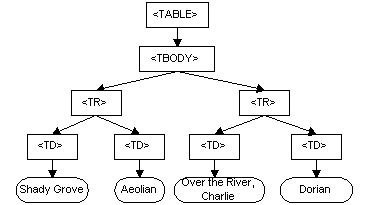文档对象模型
xml.dom 模块对于 Python 程序员来说,可能是使用 XML 文档时功能最强大的工具。不幸的是,XML-SIG 提供的文档目前来说还比较少。W3C 语言无关的 DOM 规范填补了这方面的部分空白。但 Python 程序员最好有一个特定于 Python 语言的 DOM 的快速入门指南。本文旨在提供这样一个指南。在 上一篇专栏文章 中,某些样本中使用了样本 quotations.dtd 文件,并且这些文件可以与本文中的代码样本档案文件一起使用。
有必要了解 DOM 的确切含义。这方面,正式解释非常好:
“文档对象模型”是平台无关和语言无关的接口,它允许程序和脚本动态访问和更新文档的内容、结构和样式。可以进一步处理文档,而处理的结果也可以合并到已显示的页面中。(万维网联盟 DOM 工作组)
DOM 将 XML 文档转换成树 -- 或森林 -- 表示。万维网联盟 (W3C) 规范给出了一个 HTML 表的 DOM 版本作为例子。

如上图所示,DOM 从一个更加抽象的角度定义了一组可以遍历、修剪、改组、输出和操作树的方法,而这种方法要比 XML 文档的线性表示更为便利。
将 HTML 转换成 XML
有效的 HTML 几乎就是有效的 XML,但又不完全相同。这里有两个主要的差异,XML 标记是区分大小写的,并且所有 XML 标记都需要一个显式的结束符号(作为结束标记,而这对于某些 HTML 标记是可选的;例如: <img src="X.png" /> )。使用 xml.dom 的一个简单示例就是使用 HtmlBuilder() 类将 HTML 转换成 XML。
try_dom1.py
"""Convert a valid HTML document to XML
USAGE: python try_dom1.py < infile.html > outfile.xml
"""
import
sys
from
xml.dom
import
core
from
xml.dom.html_builder
import
HtmlBuilder
# Construct an HtmlBuilder object and feed the data to it
b = HtmlBuilder()
b.feed(sys.stdin.read())
# Get the newly-constructed document object
doc = b.document
# Output it as XML
print
doc.toxml()
HtmlBuilder() 类很容易实现它继承的部分基本 xml.dom.builder 模板的功能,它的源码值得研究。然而,即使我们自己实现了模板功能,DOM 程序的轮廓还是相似的。在一般情况下,我们将用一些方法构建一个 DOM 实例,然后对该实例进行操作。DOM 实例的 .toxml() 方法是一种生成 DOM 实例的字符串表示的简单方法(在以上的情况中,只要在生成后将它打印出来)。
将 Python 对象转换成 XML
Python 程序员可以通过将任意 Python 对象导出为 XML 实例来实现相当多的功能和通用性。这就允许我们以习惯的方式来处理 Python 对象,并且可以选择最终是否使用实例属性作为生成 XML 中的标记。只需要几行(从 building.py 示例派生出),我们就可以将 Python“原生”对象转换成 DOM 对象,并对包含对象的那些属性执行递归处理。
try_dom2.py
"""Build a DOM instance from scratch, write it to XML
USAGE: python try_dom2.py > outfile.xml
"""
import
types
from
xml.dom
import
core
from
xml.dom.builder
import
Builder
# Recursive function to build DOM instance from Python instance
defobject_convert
(builder, inst):
# Put entire object inside an elem w/ same name as the class.
builder.startElement(inst.__class__.__name__)
for
attr
in
inst.__dict__.keys():
if
attr[0] ==
'_':
# Skip internal attributes
continue
value = getattr(inst, attr)
if
type(value) == types.InstanceType:
# Recursively process subobjects
object_convert(builder, value)
else
:
# Convert anything else to string, put it in an element
builder.startElement(attr)
builder.text(str(value))
builder.endElement(attr)
builder.endElement(inst.__class__.__name__)
if
__name__ ==
'__main__':
# Create container classes
classquotations
:
pass
classquotation
:
pass
# Create an instance, fill it with hierarchy of attributes
inst = quotations()
inst.title =
"Quotations file (not quotations.dtd conformant)"
inst.quot1 = quot1 = quotation()
quot1.text =
"""'"is not a quine" is not a quine' is a quine"""
quot1.source =
"Joshua Shagam, kuro5hin.org"
inst.quot2 = quot2 = quotation()
quot2.text =
"Python is not a democracy. Voting doesn't help. "+\
"Crying may..."
quot2.source =
"Guido van Rossum, comp.lang.python"
# Create the DOM Builder
builder = Builder()
object_convert(builder, inst)
print
builder.document.toxml()
函数 object_convert() 有一些限制。例如,不可能用以上的过程生成符合 XML 文档的 quotations.dtd:#PCDATA 文本不能直接放到 quotation 类中,而只能放到类的属性中(如 .text )。一个简单的变通方法就是让 object_convert() 以特殊方式处理一个带有名称的属性,例如 .PCDATA 。可以用各种方法使对 DOM 的转换变得更巧妙,但该方法的妙处在于我们可以从整个 Python 对象开始,以简明的方式将它们转换成 XML 文档。
还应值得注意的是在生成的 XML 文档中,处于同一个级别的元素没有什么明显的顺序关系。例如,在作者的系统中使用特定版本的 Python,源码中定义的第二个 quotation 在输出中却第一个出现。但这种顺序关系在不同的版本和系统之间会改变。Python 对象的属性并不是按固定顺序排列的,因此这种特性就具有意义。对于与数据库系统相关的数据,我们希望它们具有这种特性,但是对于标记为 XML 的文章却显然不希望具有这种特性(除非我们想要更新 William Burroughs 的 "cut-up" 方法)。
将 XML 文档转换成 Python 对象
从 XML 文档生成 Python 对象就像其逆向过程一样简单。在多数情况下,用 xml.dom 方法就可以了。但在某些情况下,最好使用与处理所有“类属”Python 对象相同的技术来处理从 XML 文档生成的对象。例如,在以下的代码中,函数 pyobj_printer() 也许是已经用来处理任意 Python 对象的函数。
try_dom3.py
"""Read in a DOM instance, convert it to a Python object
"""
from
xml.dom.utils
import
FileReader
classPyObject
:
pass
defpyobj_printer
(py_obj, level=0):
"""Return a "deep" string description of a Python object"""
from
string
import
join, split
import
types
descript =
''
for
membname
in
dir(py_obj):
member = getattr(py_obj,membname)
if
type(member) == types.InstanceType:
descript = descript + (
' '*level) +
'{'+membname+
'}\n'
descript = descript + pyobj_printer(member, level+3)
elif
type(member) == types.ListType:
descript = descript + (
' '*level) +
'['+membname+
']\n'
for
i
in
range(len(member)):
descript = descript+(
' '*level)+str(i+1)+
': '+ \
pyobj_printer(member[i],level+3)
else
:
descript = descript + membname+
'='
descript = descript + join(split(str(member)[:50]))+
'...\n'
return
descript
defpyobj_from_dom
(dom_node):
"""Converts a DOM tree to a "native" Python object"""
py_obj = PyObject()
py_obj.PCDATA =
''
for
node
in
dom_node.get_childNodes():
if
node.name ==
'#text':
py_obj.PCDATA = py_obj.PCDATA + node.value
elif
hasattr(py_obj, node.name):
getattr(py_obj, node.name).append(pyobj_from_dom(node))
else
:
setattr(py_obj, node.name, [pyobj_from_dom(node)])
return
py_obj
# Main test
dom_obj = FileReader(
"quotes.xml").document
py_obj = pyobj_from_dom(dom_obj)
if
__name__ ==
"__main__":
print
pyobj_printer(py_obj)
这里的关注焦点应该是函数 pyobj_from_dom() ,特别是起实际作用的 xml.dom 方法 .get_childNodes() 。在 pyobj_from_dom() 中,我们直接抽取标记之间的所有文本,将它放到保留属性 .PCDATA 中。对于任何遇到的嵌套标记,我们创建一个新属性,其名称与标记匹配,并将一个列表分配给该属性,这样就可以潜在地包含在在父代块中多次出现的标记。当然,使用列表要维护在 XML 文档中遇到的标记的顺序。
除了使用旧的 pyobj_printer() 类属函数(或者,更复杂和健壮的函数)之外,我们可以使用正常的属性记号来访问 py_obj 的元素。
Python 交互式会话
>>>
from
try_dom3
import
*
>>> py_obj.quotations[0].quotation[3].source[0].PCDATA
'Guido van Rossum, '
重新安排 DOM 树
DOM 的一大优点是它可以让程序员以非线性方式对 XML 文档进行操作。由相匹配的开/关标记括起的每一块都只是 DOM 树中的一个“节点”。当以类似于列表的方式维护节点以保留顺序信息时,则顺序并没有什么特殊之处,也并非不可改变。我们可以轻易地剪下某个节点,嫁接到 DOM 树的另一个位置(如果 DTD 允许,甚至嫁接到另一层上)。或者添加新的节点、删除现有节点,等等。
try_dom4.py
"""Manipulate the arrangement of nodes in a DOM object
"""
from
try_dom3
import
*
#-- Var 'doc' will hold the single <quotations> "trunk"
doc = dom_obj.get_childNodes()[0]
#-- Pull off all the nodes into a Python list
# (each node is a <quotation> block, or a whitespace text node)
nodes = []
while
1:
try
: node = doc.removeChild(doc.get_childNodes()[0])
except
:
break
nodes.append(node)
#-- Reverse the order of the quotations using a list method
# (we could also perform more complicated operations on the list:
# delete elements, add new ones, sort on complex criteria, etc.)
nodes.reverse()
#-- Fill 'doc' back up with our rearranged nodes
for
node
in
nodes:
# if second arg is None, insert is to end of list
doc.insertBefore(node, None)
#-- Output the manipulated DOM
print
dom_obj.toxml()
如果我们将 XML 文档只看作一个文本文件,或者使用一个面向序列的模块(如 xmllib 或 xml.sax),那么在以上几行中执行对 quotation 节点的重新安排操作将引出一个值得考虑的问题。然而如果使用 DOM,则问题就如同对 Python 列表执行的任何其它操作一样简单。
jsjbwy


